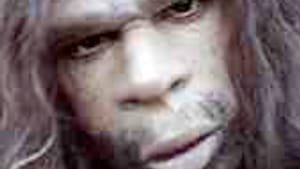Stay in the Loop
BSR publishes on a weekly schedule, with an email newsletter every Wednesday and Thursday morning. There’s no paywall, and subscribing is always free.
They couldn't talk, but boy, could they hum
Mithen's "Singing Neanderthals'

Now that Neanderthals are back in the news"“ in case you haven't heard, we slept with them"“ it is a timely moment to talk about one of my favorite books from a few years ago, Steven Mithen's underappreciated, forward-looking The Singing Neanderthals.
I can't imagine why a book with subchapter titles like "The origin of 'hmmmmm' communication," "Neanderthals in love" and "Vivaldi's Concerto in B flat Major For Trumpet and Orchestra: a member of Homo heidelbergensis showing off a hand-axe he has made," failed to find a wider readership.
Steven Mithen, dean and professor of archaeology at the University of Reading in the U.K., is all about science. He specializes in late Pleistocene and early Holocene hunter-gatherers, computational archaeology and human development. He has a bit of a sense of humor "“ he refers to the old quip that the Neanderthals were just a haircut away from civilization"“ and can tap into musical references that stretch from the songs of the chocolate-backed kingfisher to Gustave Mahler.
Above all, his thesis opens up a music-filled box of speculation about the ways humans think, dance, sing and speak.
According to Mithen, Neanderthals survived for some 250,000 years under horrific conditions in northern Eurasian regions before abruptly disappearing 30,000 years ago. They had relatively large brains and were capable of hunting animals, making tools, interacting with the natural world, and harmoniously sustaining socialization in closely bound communities.
Intensely emotional
They were also, Mithen contends, "intensely emotional beings," who were happy and sad, envious and grieving, guilty and loving. In part, this was because while they had large-sized brains, the components were neither elaborately connected nor capable of retaining much information. For the Neanderthals, it was all emo and "Like, so, I know those trees and, so, let's make axes," and "Wanna hunt?" and, "So, like, time now for sex." They were not smarter than a fifth grader and, truth to tell, they could not even articulate the near-sentences above.
And this is the fascinating point: They lacked language as we know it. Instead of speaking, they employed expressive gestures, movements and sounds to communicate. According to the evidence Mithen cites, Neanderthals could sing, dance, mime and hummmmm. Who could ask for anything more?
By Hummmmm, Mithen means that in place of a verbal language, the brainy Neanderthals developed "a sophisticated communication system that was Holistic, manipulative, multi-modal, musical and mimetic in character" (or, Hmmmmm). As Hmmmmmers, or singers, Neanderthals relied on selected, meaningful vocalizations and use of rhythm, pitch, duration, varied tonguing and breathing patterns to communicate orally. Mithen suggests they were also quite the listeners, tuned to nuances of grunts, swallows, whistles and the clicking of teeth.
Doo-wop without lyrics
Think about it: This is was a world where scatting went on all day, a world of doo-wop without lyrics and dada sound poems until the cows came home, where everyone moves and barks and mumbles but still understands each other.
So what if it was the Ice Age? Life was a cabaret, a songfest without words, a heigh-ho heigh-ho daily musical, a supercalifragalisticexpealadocious, mares eat oats and does eat oats and baa baa boo hooing, yada yada yada jibber jabber hip hop era, or eon, or whatever. With some opera, too, or così fan tutti.
Of course, Mithen doesn't indulge in this kind of frivolous erudition (that is my field: acadecomics). He's a rigorous scholar and builds on the research of linguists, cognitivists, ethnomusicologists and others.
Birds do it, bees do it
One of the joys of this book is Mithen's cogent survey of studies of the origins of bipedalism, dance, music and language. The formal question Mithen pursues is threefold: What is the origin of language? What is the function of music in human experience? And how did the mind of homo sapiens evolve?
The short answer is that just the way birds do it and bees do it, Neanderthals developed a musilanguage, where pitch and intonation contributed to the meaning of verbal utterances. This isn't unlike some Chinese dialects, whose tonality and inflections are significant.
For Mithen and others, this discovery suggests that Neanderthals had to possess perfect pitch, as most babies and some monkeys do. Evolutionarily speaking, perfect pitch is great for musicians but distracting in terms of using language in more complex and functional ways.
In the end, sadly, Neanderthals encountered straight talkers, who were also more organized and aggressive. The new kids on the block didn't understand the Neanderthals' act and so the Neanderthal show closed. Their successors"“ us"“ were also more visual and better toolmakers. In the blink of an ear, it was all bye-bye Hummmmming and hello tattoos and tweeting.
I can't imagine why a book with subchapter titles like "The origin of 'hmmmmm' communication," "Neanderthals in love" and "Vivaldi's Concerto in B flat Major For Trumpet and Orchestra: a member of Homo heidelbergensis showing off a hand-axe he has made," failed to find a wider readership.
Steven Mithen, dean and professor of archaeology at the University of Reading in the U.K., is all about science. He specializes in late Pleistocene and early Holocene hunter-gatherers, computational archaeology and human development. He has a bit of a sense of humor "“ he refers to the old quip that the Neanderthals were just a haircut away from civilization"“ and can tap into musical references that stretch from the songs of the chocolate-backed kingfisher to Gustave Mahler.
Above all, his thesis opens up a music-filled box of speculation about the ways humans think, dance, sing and speak.
According to Mithen, Neanderthals survived for some 250,000 years under horrific conditions in northern Eurasian regions before abruptly disappearing 30,000 years ago. They had relatively large brains and were capable of hunting animals, making tools, interacting with the natural world, and harmoniously sustaining socialization in closely bound communities.
Intensely emotional
They were also, Mithen contends, "intensely emotional beings," who were happy and sad, envious and grieving, guilty and loving. In part, this was because while they had large-sized brains, the components were neither elaborately connected nor capable of retaining much information. For the Neanderthals, it was all emo and "Like, so, I know those trees and, so, let's make axes," and "Wanna hunt?" and, "So, like, time now for sex." They were not smarter than a fifth grader and, truth to tell, they could not even articulate the near-sentences above.
And this is the fascinating point: They lacked language as we know it. Instead of speaking, they employed expressive gestures, movements and sounds to communicate. According to the evidence Mithen cites, Neanderthals could sing, dance, mime and hummmmm. Who could ask for anything more?
By Hummmmm, Mithen means that in place of a verbal language, the brainy Neanderthals developed "a sophisticated communication system that was Holistic, manipulative, multi-modal, musical and mimetic in character" (or, Hmmmmm). As Hmmmmmers, or singers, Neanderthals relied on selected, meaningful vocalizations and use of rhythm, pitch, duration, varied tonguing and breathing patterns to communicate orally. Mithen suggests they were also quite the listeners, tuned to nuances of grunts, swallows, whistles and the clicking of teeth.
Doo-wop without lyrics
Think about it: This is was a world where scatting went on all day, a world of doo-wop without lyrics and dada sound poems until the cows came home, where everyone moves and barks and mumbles but still understands each other.
So what if it was the Ice Age? Life was a cabaret, a songfest without words, a heigh-ho heigh-ho daily musical, a supercalifragalisticexpealadocious, mares eat oats and does eat oats and baa baa boo hooing, yada yada yada jibber jabber hip hop era, or eon, or whatever. With some opera, too, or così fan tutti.
Of course, Mithen doesn't indulge in this kind of frivolous erudition (that is my field: acadecomics). He's a rigorous scholar and builds on the research of linguists, cognitivists, ethnomusicologists and others.
Birds do it, bees do it
One of the joys of this book is Mithen's cogent survey of studies of the origins of bipedalism, dance, music and language. The formal question Mithen pursues is threefold: What is the origin of language? What is the function of music in human experience? And how did the mind of homo sapiens evolve?
The short answer is that just the way birds do it and bees do it, Neanderthals developed a musilanguage, where pitch and intonation contributed to the meaning of verbal utterances. This isn't unlike some Chinese dialects, whose tonality and inflections are significant.
For Mithen and others, this discovery suggests that Neanderthals had to possess perfect pitch, as most babies and some monkeys do. Evolutionarily speaking, perfect pitch is great for musicians but distracting in terms of using language in more complex and functional ways.
In the end, sadly, Neanderthals encountered straight talkers, who were also more organized and aggressive. The new kids on the block didn't understand the Neanderthals' act and so the Neanderthal show closed. Their successors"“ us"“ were also more visual and better toolmakers. In the blink of an ear, it was all bye-bye Hummmmming and hello tattoos and tweeting.
What, When, Where
The Singing Neanderthals: The Origins of Music, Language, Mind and Body. By Stephen Mithen. Harvard University Press, 2007. 384 pages; $18.00. www.amazon.com.
Sign up for our newsletter
All of the week's new articles, all in one place. Sign up for the free weekly BSR newsletters, and don't miss a conversation.

 AJ Sabatini
AJ Sabatini